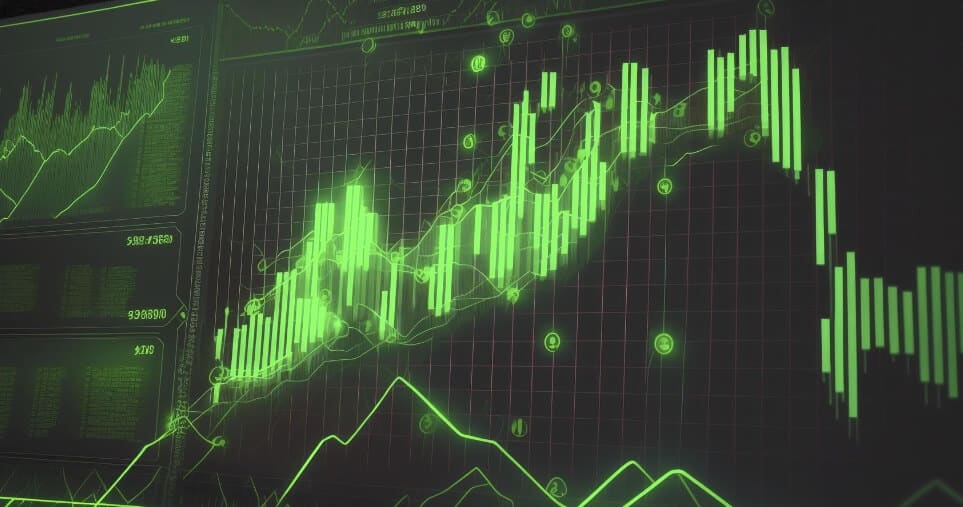
This blog unveils the secrets of a powerful forex trading tool – the Exponential Moving Average (EMA). Discover how EMA, with its unique calculations, provides traders with insights on trend direction. As well as how it helps influence strategic decisions for optimal entry and exit points. In this exploration, gain insights into the distinctive features of EMA. Find out what sets it apart from its counterparts, shaping the landscape of informed forex trading.
The exponential moving average (EMA) is a widely used tool in forex trading. It helps traders determine entry and exit points for their trades. An overlay on trading charts, it’s often used in conjunction with other indicators. Examples of these other indicators are moving average convergence divergence (MACD) and the relative strength index (RSI).
Key Takeaways
- The exponential moving average (EMA) is a forex trading tool used to identify entry and exit points in trades.
- The EMA reacts faster to price changes and gives more weight to recent data than a simple moving average (SMA).
- Forex traders use a combination of shorter-term and longer-term EMAs to determine buy and sell signals.
- EMA crossovers and the relationship between price and EMA levels are commonly used as trading indicators.
- Choosing the right EMA periods depends on the trader’s preferences and the timeframe of the chart being analysed.
What is Exponential Moving Average in Forex
Forex traders frequently encounter resistance or support at long-term EMA crossover points and observe increased trading volume in these areas. The EMA differs from a simple moving average (SMA). The difference is that it gives more weight to recent data and responds more quickly to price changes.
Traders commonly employ a shorter-term EMA and a longer-term EMA to generate buy and sell signals based on their positioning relative to each other. Popular EMA timelines used in forex trading include 5, 10, 12, 20, 26, 50, 100, and 200.
Exploring the Significance of Exponential Moving Average (EMA) in Forex Trading
In forex trading, the Exponential Moving Average (EMA) emerges as a vital analytical tool. Reason being, it helps with informed decision-making and strategic trading. Understanding the essence of EMA involves delving into its unique characteristics. It’s also important to know how it’s different from the Simple Moving Average (SMA).
EMA vs SMA: What Are the Distinctions
Heading into the heart of EMA, it is essential to grasp its fundamental differences from the Simple Moving Average (SMA). While both indicators gauge trend direction over time, EMA distinguishes itself by placing more weight on recent data. This nuanced approach allows EMA to react more promptly to price changes compared to the slower-moving SMA.
EMA’s Role in Entry and Exit Strategies
EMA’s popularity in forex circles lies in its efficacy for determining optimal entry and exit points in trades. Traders often overlay the EMA on their charts to visually assess the relationship between price action and the EMA line. For instance, if the price is positioned above the EMA, it signals a potential selling or short-selling opportunity. On the contrary, a price below the EMA may prompt a buying decision.
Interpreting EMA:
Utilising EMA effectively requires a strategic approach to interpretation. Traders are advised to follow the same rules applied to SMA, with a keen awareness of EMA’s sensitivity to price movements. This sensitivity acts as a double-edged sword, offering early trend identification but also making EMA more susceptible to short-term fluctuations.
EMA and Support/Resistance Dynamics
Beyond trend identification, EMA plays a crucial role in identifying support and resistance levels. A rising EMA is indicative of price support, while a falling EMA provides resistance to price action. This insight guides traders in making decisions aligned with market dynamics. An example is buying near a rising EMA and selling when prices approach a falling EMA.
Decoding the EMA Formula
At the core of EMA lies a mathematical formula that distinguishes it from its counterparts. Here is the EMA formula, EMA = (K x (C – P)) + P. This incorporates the exponential smoothing constant (K), which assigns appropriate weight to the most recent price. This formula, in contrast to SMA, places more emphasis on recent price data, influencing the overall responsiveness of EMA.
Crafting Trading Strategies with EMA
One of the prevailing forex strategies involves the use of short-term and long-term EMAs. Traders strategically enter buy orders when the short-term EMA crosses above the long-term EMA. The opposite is true when traders initiate sell orders when the short-term EMA crosses below the long-term EMA. This approach leverages the crossover of EMAs for enhanced decision-making.
Choosing EMA Periods: Tailoring to Timeframes
Deciphering the significance of EMA periods is crucial for traders. The selection of periods, such as 5, 10, 12, 20, 26, 50, 100, and 200, corresponds to specific timeframes. Shorter timeframe traders may opt for EMAs like 5 and 10. However, longer timeframe traders prefer higher EMAs such as 20 and 50. The choice of EMA periods aligns with the trader’s preferred timeframe for effective trend analysis.
EMA in Action: Visualising Chart Performance
To comprehend the impact of EMA, let’s consider a practical example. Examining a 4-hour chart of USD/JPY, the EMA, particularly the 30 EMA, appears closer to recent price action compared to the 30 SMA. This visual representation underscores EMA’s emphasis on recent market dynamics, offering traders a real-time perspective.
The Exponential Moving Average (EMA) is a cornerstone in a forex trader’s toolkit. It offers a nuanced and dynamic approach to trend analysis. Understanding its intricacies empowers traders to navigate the ever-evolving forex landscape with precision and confidence.
Leveraging EMA for Forex Trading: A Trader’s Strategic Ally
Grasp the essence of the foreign exchange market (forex) and its 24-hour, decentralised nature. Understand the vital role of currency exchanges in global transactions. It’s also important to know how central banks, financial institutions, and individual traders contribute to the constant fluctuations in currency values.
Next, explore how forex traders rely on EMA as a key tool for establishing buy and sell points based on price trends. Understand the strategic use of short-term and long-term EMAs to pinpoint convergence points and make informed trading decisions.
The Forex Landscape: A Global Perspective
In the expansive realm of forex trading, often referred to as the FX market, participants engage in a 24-hour electronic marketplace for the exchange of currencies. This global market operates without a central owner or headquarters, making it a decentralised hub where currencies are traded incessantly. Central banks, significant financial institutions, and individual traders contribute to the constant fluctuations in currency values, driven by the dynamic interplay of supply and demand.
Currency exchanges are not only integral for businesses conducting international transactions but also serve as a platform for central banks to stabilise their currencies. This intricate web of trading activities in the forex market creates a landscape where opportunities and risks abound, demanding tools that can decipher market trends with precision.
EMA as a Forex Trader’s Ally: Leveraging Analytical Precision
Within this dynamic landscape, the Exponential Moving Average (EMA) emerges as a steadfast ally for forex traders seeking analytical precision. Traders deploy EMA to navigate the complexities of the forex market and make well-informed decisions based on trend analysis.
Consider a scenario where a trader utilises a short-term and a long-term EMA to trace the convergence point between the two. This strategic approach allows the trader to identify potential buying or selling opportunities with enhanced accuracy. The EMA’s sensitivity to recent price changes proves invaluable in this context, providing traders with real-time insights into market dynamics.
Enhancing Trading Precision with EMA
As a trader’s ally, the EMA aids in enhancing precision when establishing buy and sell points. By strategically incorporating short-term and long-term EMAs, traders can pinpoint convergence points that signal opportune moments to enter or exit a trade.
For instance, envision a trader observing the crossover of the short-term EMA above the long-term EMA. This scenario often prompts a trader to initiate a buy order, anticipating a potential upward trend. Conversely, when the short-term EMA crosses below the long-term EMA, a sell order might be considered, indicating a potential downturn in the market.
Unlocking Trends with EMA in Different Timeframes
The flexibility of EMA extends to its ability to cater to traders with varying timeframes. Shorter timeframe traders, analysing charts on a five- or fifteen-minute basis, may find the 5 and 10 EMAs more suitable. In contrast, traders examining higher timeframes lean towards the 20 and 50 EMAs. The 50, 100, and 200 EMAs are particularly significant for those engaged in longer-term trend trading.
By aligning the choice of EMA periods with specific timeframes, traders can customise their analytical approach, adapting to the pace and scope of their preferred trading intervals.
Conclusion: EMA as the North Star in Forex Trading
In the multifaceted forex landscape, the Exponential Moving Average (EMA) emerges as a reliable and versatile ally for traders. By understanding and harnessing the power of EMA, traders can navigate the intricacies of the forex market with analytical precision, identifying trends, making strategic decisions, and ultimately enhancing their overall trading performance. EMA stands as the North Star guiding traders through the ever-changing currents of the global forex landscape.
The Role of Exponential Moving Average in Forex Strategies
In the world of forex trading, the exponential moving average (EMA) plays a crucial role in the development and implementation of effective trading strategies. As forex traders aim to identify profitable opportunities in the market, they rely on various technical analysis tools, and the EMA stands out as one of the most widely used indicators.
When crafting a forex strategy, traders often select both a shorter-term EMA and a longer-term EMA. These moving averages are calculated by taking the average of the preceding time period, typically expressed in days. For example, a 20-day EMA represents the average of the last 20 days.
EMA As a Trend Indicator
The EMA helps traders identify trends in the forex market by smoothing out price fluctuations and emphasising recent data. By focusing on recent price movements, the EMA reacts faster to changes in market conditions compared to other indicators such as the simple moving average (SMA).
Forex traders commonly use the crossover of EMA lines as a trading signal. When the shorter-term EMA crosses above the longer-term EMA, it is seen as a buy signal. Conversely, when the shorter-term EMA crosses below the longer-term EMA, it is considered a sell signal. This crossover strategy helps traders enter and exit positions at opportune moments, taking advantage of trends in the market.
The position of the EMA relative to price is also important in forex strategies. If the price remains above the selected EMA level, traders tend to stay on the buy side, indicating a bullish trend. On the other hand, if the price falls below the EMA level, traders consider selling, unless the price crosses back above the EMA, suggesting a potential trend reversal.
The EMA is a versatile indicator that can be used in a combination of ways to optimise trading strategies. It is often complemented by other technical analysis tools such as oscillators or chart patterns to confirm trend changes and increase the accuracy of trading decisions.
By incorporating the EMA into their forex strategies, traders can effectively identify market trends, generate buy and sell signals, and enhance their overall trading performance.
| Advantages | Disadvantages |
|---|---|
| React faster to market changes Enhance trend identification Provide clear entry and exit signals | May generate false signals in ranging markets Not suitable as a standalone indicator Requires careful analysis and parameter selection |
Using Exponential Moving Average as a Buy/Sell Indicator
Traders in the forex market often rely on the crossover of Exponential Moving Average (EMA) lines as a key buy or sell signal in their trading strategies. When the shorter-term EMA, such as the 10 or 20 EMA, crosses above the longer-term EMA, such as the 50 EMA, it is considered a bullish signal to buy. Conversely, when the shorter-term EMA crosses below the longer-term EMA, it is seen as a bearish signal to sell.
However, traders not only use EMA crossovers but also observe the relationship between a single EMA and price to guide their trading decisions. If the price remains consistently above the selected EMA level, it signals a bullish trend, and the trader stays on the buy side. On the other hand, if the price falls below the EMA level, the trader would consider selling, unless the price subsequently crosses back above the EMA.
The choice of EMA periods depends on the trader’s preferences and the timeframe of the chart being analysed. Shorter EMAs, such as the 10 or 20 EMA, are typically favoured for shorter timeframes, such as day trading or scalping strategies. These shorter EMAs are more responsive to recent price changes, allowing traders to capture quick market movements. Conversely, longer EMAs, such as the 50, 100, or 200 EMA, are commonly used for longer-term trend trading or swing trading. These longer EMAs provide a smoother average and help identify broader market trends.
Example:
To illustrate the use of EMA crossovers as buy/sell signals, consider the following example:
| Date | Price | 10 EMA | 50 EMA | Signal |
|---|---|---|---|---|
| 01/01/2022 | 100 | 96 | 90 | |
| 01/02/2022 | 110 | 100 | 92 | Buy |
| 01/03/2022 | 105 | 103 | 94 | |
| 01/04/2022 | 95 | 104 | 96 | Sell |
| 01/05/2022 | 100 | 101 | 97 |
In the above example, when the 10 EMA crosses above the 50 EMA, it generates a buy signal. On 01/02/2022, the price is 110, and the 10 EMA is above the 50 EMA. This indicates a bullish trend, and traders may consider buying. Similarly, when the 10 EMA crosses below the 50 EMA, it generates a sell signal. On 01/04/2022, the price falls to 95, and the 10 EMA is below the 50 EMA, signaling a bearish trend and a potential sell opportunity.
Using EMA crossovers and observing the relationship between the EMA and price can help traders make informed buy and sell decisions in the dynamic forex market.
Conclusion
The exponential moving average (EMA) is a powerful indicator that forex traders use to make informed decisions in their trading strategies. With its ability to react quickly to recent price changes, the EMA provides valuable insights into market trends and assists in identifying entry and exit points.
Traders often rely on the crossover of EMA lines as trading signals to determine when to buy or sell. Additionally, they observe the EMA in relation to price to confirm trends, making it an essential tool in their technical analysis arsenal.
By combining the EMA with other indicators, forex traders can further enhance their technical analysis and increase the accuracy of their trading decisions. The choice of EMA periods is subjective and depends on the trader’s preferences and the timeframe of the chart being analysed.
Understanding the role and calculation of the EMA empowers forex traders to develop effective strategies and navigate the dynamic forex market with confidence. Incorporating the EMA into trading systems provides a sound foundation for successful trading and offers valuable insights into market trends and potential opportunities.
FAQ
The exponential moving average (EMA) is a commonly used forex trading tool that helps determine entry and exit points for trades. It is an overlay on trading charts and is used in conjunction with other indicators like moving average convergence divergence (MACD) and the relative strength index (RSI).
The EMA gives more weight to recent data and reacts faster to price changes compared to the SMA. Traders often use a shorter-term EMA and a longer-term EMA to determine buy and sell signals based on their position relative to each other.
Traders select a shorter-term EMA and a longer-term EMA and enter buy orders when the shorter-term EMA crosses above the longer-term EMA and sell orders when the shorter-term EMA crosses below the longer-term EMA.
Common EMA timelines used by forex traders are 5, 10, 12, 20, 26, 50, 100, and 200.
The EMA is frequently used in conjunction with other indicators to confirm trend changes and optimise trading strategies. Traders often observe the EMA in relation to price to guide their trading decisions.
Traders often use the crossover of EMA lines as a buy or sell signal. For example, a crossover of the 50 EMA by the 10 or 20 EMA can be considered a trading signal.
Traders observe a single EMA in relation to price to guide their trading decisions. If the price remains above the selected EMA level, the trader remains on the buy side, and if the price falls below the EMA level, the trader considers selling unless the price crosses above the EMA.
The choice of EMA periods depends on the trader’s preferences and the timeframe of the chart being analysed. Shorter EMAs are favoured for shorter timeframes, while longer EMAs are used for longer-term trend trading.
















